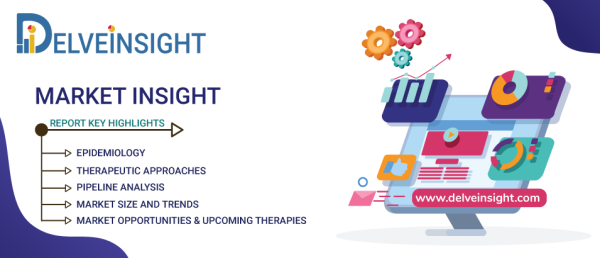Hyperinsulinemic Hypoglycemia Market: Analysis of Epidemiology, Pipeline Therapies, and Key Companies Working in the Market
Hyperinsulinemic Hypoglycemia Market: Analysis of Epidemiology, Pipeline Therapies, and Key Companies Working in the Market
DelveInsight’s “Hyperinsulinemic Hypoglycemia Market Insights, Epidemiology, and Market Forecast-2032“ report delivers an in-depth understanding of the Hyperinsulinemic Hypoglycemia, historical and forecasted epidemiology as well as the Hyperinsulinemic Hypoglycemia market trends in the United States, EU5 (Germany, Spain, Italy, France, and United Kingdom) and Japan.
The Hyperinsulinemic Hypoglycemia market report provides current treatment practices, emerging drugs, Hyperinsulinemic Hypoglycemia market share of the individual therapies, current and forecasted Hyperinsulinemic Hypoglycemia market Size from 2019 to 2032 segmented by seven major markets. The Report also covers current Hyperinsulinemic Hypoglycemia treatment practice/algorithm, market drivers, market barriers and unmet medical needs to curate the best of the opportunities and assesses the underlying potential of the Hyperinsulinemic Hypoglycemia market.
Got queries? Click here to know more about the Hyperinsulinemic Hypoglycemia Market Landscape

Hyperinsulinemic Hypoglycemia Overview
Hyperinsulinemic hypoglycemia is characterized by unregulated insulin release, leading to persistently low blood glucose concentrations with lack of alternative fuels, which increases the risk of neurological damage in these patients. Primary hyperinsulinism is a rare but important cause of hypoglycemia in infants and children. It is the most common cause of neonatal hypoglycemia that persists beyond the first few hours of life.
The clinical presentation varies with the age of the child. Early diagnosis and treatment are essential to prevent seizures and neurologic sequelae
Hyperinsulinemic Hypoglycemia Epidemiology Insights
A total of 23 different disease-causing mutations have been identified. In approximately 70% of the cases, the mutations are de novo.98 Among the 30% of familial cases, a clear autosomal dominant pattern of inheritance is evident.
The clinical presentation is characterized by hypoglycemia due to hyperinsulinism together with a characteristically persistent but asymptomatic elevation of plasma ammonia. Hypoglycemia is usually recognized by around 4 to 12 months of life and birth size is normal. Plasma ammonia levels in HI/HA are elevated three to five times above the normal range to approximately 60 to 150 μmol/L. Ammonia levels are quite constant, and in contrast to the urea cycle enzyme defects, do not increase with protein feeding. The hyperammonemia does do not appear to cause symptoms and does not require treatment.
GDH is a mitochondrial matrix enzyme that is a key regulator of amino acid and ammonia metabolism in pancreatic β-cells, liver, kidney, and brain. As shown in Figure 6-7, GDH functions in the beta cell pathway of leucine-stimulated insulin secretion. Leucine is an allosteric activator of the enzyme, causing increased oxidation of glutamate to α-ketoglutarate and increased ATP production—which results in insulin release. The HI/HA mutations affect either the inhibitory GTP-binding site or the antenna loop of the enzyme, which communicates between adjacent subunits, impairing the inhibitory allosteric effect of GTP on GDH enzyme activity, thus leading to excessive insulin release.
Hyperinsulinemic Hypoglycemia Epidemiology Segmentation
-
Hyperinsulinemic Hypoglycemia is a rare condition and is clinically significant in about 1 in 100,000. Cryoglobulins have been identified in several situations, specifically, including 15% to 20% of HIV-infected individuals, 40 to 65 percent of Hepatitis C-infected patients, and approximately 64 percent of HIV/HepC coinfected individuals.
-
Patients with type 1 cryoglobulin are anywhere from 5% to 25% of the cases based on the currently available case series.
Hyperinsulinemic Hypoglycemia Market Outlook
The Hyperinsulinemic Hypoglycemia market outlook of the report helps to build a detailed comprehension of the historic, current, and forecasted Hyperinsulinemic Hypoglycemia market trends by analyzing the impact of current Hyperinsulinemic Hypoglycemia therapies on the market, unmet needs, drivers and barriers, and demand for better technology.
This segment gives a thorough detail of Hyperinsulinemic Hypoglycemia market trend of each marketed drug and late-stage pipeline therapy by evaluating their impact based on the annual cost of therapy, inclusion and exclusion criteria’s, mechanism of action, compliance rate, growing need of the market, increasing patient pool, covered patient segment, expected launch year, competition with other therapies, brand value, their impact on the market and view of the key opinion leaders. The calculated Hyperinsulinemic Hypoglycemia market data are presented with relevant tables and graphs to give a clear view of the market at first sight.
According to DelveInsight, the Hyperinsulinemic Hypoglycemia market in 7MM is expected to witness a major change in the study period 2019-2032.
Learn more by requesting for sample @ Hyperinsulinemic Hypoglycemia Market Trends
Hyperinsulinemic Hypoglycemia Key Companies
-
Xeris Pharmaceuticals
-
Eiger Biopharmaceuticals
-
Zealand Pharmaceuticals
-
Novartis Pharmaceuticals
-
And many others
Hyperinsulinemic Hypoglycemia Therapies
Glucagon RTU
Avexitide
dasiglucagon
Pasireotide
Table of Contents
-
Key Insights
-
Report Introduction
-
Executive Summary of Hyperinsulinemic Hypoglycemia
-
Disease Background and Overview
-
Epidemiology and patient population
-
Hyperinsulinemic Hypoglycemia Emerging Therapies
-
Hyperinsulinemic Hypoglycemia Market Outlook
-
Market Access and Reimbursement of Therapies
-
Market Drivers
-
Market Barriers
-
Appendix
-
Hyperinsulinemic Hypoglycemia Report Methodology
-
DelveInsight Capabilities
-
Disclaimer
Click here to read more about Hyperinsulinemic Hypoglycemia Market
Media Contact
Company Name: DelveInsight Business Research LLP
Contact Person: Kritika Rehani
Email: Send Email
Phone: 9193216187
Address:304 S. Jones Blvd #2432
City: Las Vegas
State: Nevada
Country: United States
Website: https://www.delveinsight.com/




